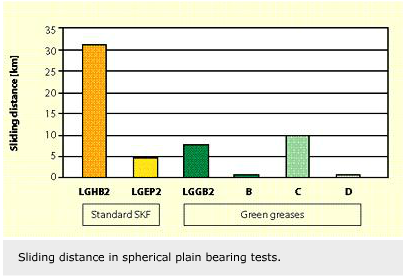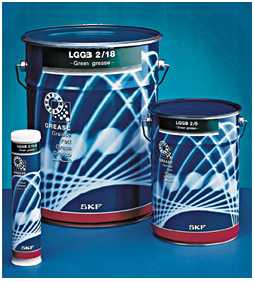
Inherent advantages of biodegradable lubricants
A new biodegradable grease from SKF can match traditional grease performance in bearing applications. It also meets the increased demand for environmentally friendly products in the engineering industry.
Summary
Overcoming the limitations of biodegradable lubricants has been a goal of SKF for many years. Thanks to its specialist knowledge of bearing behaviour and the effects of lubrication, the company has now launched its first green grease, which is believed to be the first of its kind on the open market.
Developed to meet a range of bearing applications, the new grease, called LGGB 2, meets the strict criteria that SKF places on bearing greases. It has been tested and approved for steel-on-steel spherical plain bearings, ball and roller bearings.
The new grease is part of the group’s continued commitment to the environment and the adoption of sound environmental practices within the bearing industry.
SKF has launched its “green” grease, LGGB 2 product, as a general-purpose lubricant. As such it is suitable for many different types of bearing applications. This contrasts with other biodegradable and non-biodegradable greases, which often require one particular type of grease per application. The grease is also a highly competitive alternative to traditional greases.
The development has come about through SKF working with its own suppliers to identify the suitable characteristics and performance requirements for environmentally friendly grease. The application of biodegradable lubricants and greases has been studied at the SKF Engineering & Research Centre for a number of years. This has led to a formulation that can meet the stringent demands of a range of engineering applications without adverse effects on the environment.
Although only a portion of lubricants used may pose a threat to the environment, this can add up to several millions tonnes worldwide. In particular, equipment users in the construction, earthmoving, forestry and farming industry are increasingly seeking “green” solutions because environmental contamination may be an issue.
Until recently, it was thought that current generations of biodegradable and low-toxicity lubricants could not satisfactorily meet the requirements of rolling bearing applications.
SKF has managed to overcome the inherent disadvantages of biodegradable greases, which have led to premature bearing failure. LGGB 2 has been tested and approved for steel-on-steel spherical plain bearings, ball and roller bearings. The grease is based on synthetic ester oil, lithium/calcium thickener and other biodegradable ingredients, and it has low toxicity.
Study of requirements
The search for a suitable biodegradable and low-toxicity lubricant involved a number of key issues. These included:
- current and proposed environmental legislation relevant to lubricants,
- existing products on the market and their performance,
- demand for the product,
- properties for the product, and
- current research.
A central issue was to establish a clear definition of the term “green grease.” Most materials will degrade in some way over time. There are many processes responsible for these changes, mostly commonly biodegradation, oxidation and photolysis. Chemical and physical changes over time often occur simultaneously.
With regard to the development of clear parameters on material breakdown in the context of a green grease , the understanding of biodegradation is vital. In biodegradation, the material is gradually broken down through the metabolic action of such living organisms as bacteria, fungi, yeast and algae. Hydrocarbons, which are the main constituent of biodegradable lubricants, are transformed into carbon dioxide andwater by this process.
Naturally, this process is not entirely predictable as it can be influenced for example by the mix of living organisms present, temperature and humidity. It can happen that a material that may easily degrade under one set of circumstances may not readily degrade under others.
The minimum basic requirements are sufficient bacteria population, correct oxygen levels and a suitable temperature range. The rate of degradation is also affected by such factors as fluid viscosity, sunlight, mineral salt content, availability of nitrogen, pH levels, solubility and the ability of bacteria to adapt to the source of oil nutrient. Ultimately, of course, the lubricant should be reduced to its simplest natural form while leaving no harmful by-products that could have a detrimental and long-term effect on the local environment.
Traditional lubricants based on mineral and synthetic oils are ultimately biodegradable though the slow rate of decomposition means, under some conditions, that they can exist as a contaminant in groundwater for close to a century.
Testing regimens
Any tests to establish the biodegradable performance of a new lubricant have to bear in mind the often unpredictable and complex processes at work.
With no single universal standard that clearly defines biodegradability, SKF opted to use a number of existing tests. These were used to establish whether toxicity and biodegradability occurred within a reasonable length of time.
Basically, biodegradability means that microorganisms in the soil, rivers and oceans can break down greases with relative ease.
From exhaustive studies, ester or vegetable fluids formulated carefully into lubricants have been found to perform well in real applications. In particular, SKF researchers found that a combination of synthetic ester oil and a lithium/calcium thickener resulted in good properties as defined in terms of water and corrosion resistance without the need to use toxic additives.
The LGGB 2 grease formulation, based on these constituents, performs well with ball, roller and plain bearings. This is a significant development, as conventional lubricating greases are normally considered suitable for only one bearing type. Each bearing class has a different contact surface, which can affect lubricant performance. For instance, the lubricant film in ball bearings has a point contact; in roller bearings it is a line contact; and for plain bearings it is full contact over the area.
SKF selected four different formulations that were subjected to stringent bearing tests. These included:
- the SKF R0F test to determine performance in ball bearings and determine the maximum operating temperature limit,
- the SKF EMCOR test, which tests corrosion inhibition properties,
- the R2F test to establish grease lubrication performance in roller bearings, and
- the SKF steel-on-steel plain bearing test.
From these tests, it was found that LGGB 2 offered superior performance over a range of operating conditions and bearing types and established a steady operating temperature set at 90 °C.
Peter Oosterman
SKF Maintenance Products, Mijdrecht, the Netherlands.







